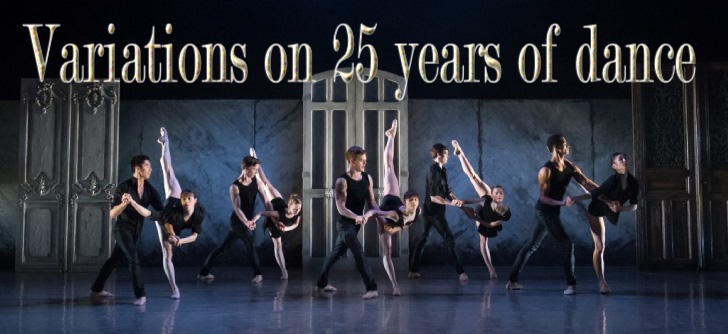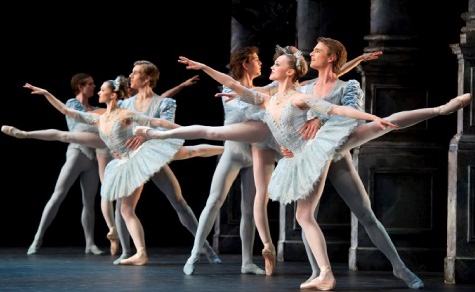|

Variations Triple Bill
Birmingham Royal Ballet
Birmingham Hippodrome
*****
FRESH from
their quite stunning performance as Siegfried and Odette/Odile in last
week’s Swan Lake,
Momoko Hirata and Joseph Caley teamed up again in
Theme and Variations,
the opening ballet of BRB’s Triple Bill.
The MoJo pairing is becoming a formidable
partnership with a delightful mix of grace, elegance and poise which is
easy on both eye and senses; nothing is rushed and everything flows.
They are the lead couple in George Balanchine’s
homage to the classical dance style of St Petersburg engendered by
Tchaikovsky’s glorious scores; it was, incidentally, the first piece to
be performed at the Hippodrome by the newly created Birmingham Royal
Ballet 25 years ago.
The 12 variations of
Tchaikovsky’s theme, from Orchestral
Suite No 3, weaves corps and soloists
in classical ballet costume, powder blue tutus and tights, so cleverly
that you can almost believe the dancers are telling a story, some
fantastic fairytale, even though none is there. It is just a beautiful,
classical illusion with quite lovely classical pas de deux from Momoko
and Caley.
Peter Farmer’s designs are simple but sumptuous
with five candle lit chandeliers above a stage flanked by rich midnight
blue drapes with silver flashes.
This is in contrast to former BRB dancer
Jean-Marc Puissant’s more stark design for Kin. with its marble walls
and slabs and unmatched, unattached doors at the rear of the stage. The
full point incidentally is to give a double meaning to the word kin as
both standing for family and as a curtailed form of kinetic.
This is a piece choreographed by Alexander
Whiteley who joined BRB in 2000 before leaving to join Rambert Dance
Company and had its world premiere at the Crescent Theatre last year when BRB opened the International Dance Festival
Birmingham.
Theatre last year when BRB opened the International Dance Festival
Birmingham.
The music here is from
American composer Phil Kline’s The Blue
Room and Other Stories which was
written originally for New York based avant garde string quartet, ETHEL
and sees Elisha Willis in a series of sensuous solos and lovely pas de
deux with Caley, again, among 10 dancers in five couples all dressed in
black.
As a dance piece it is contemporary and
mesmerising to watch and as male and female forms intertwine, creating
changing shapes; it manages to be both sensuous and asexual, there is no
romantic story, or even a hint of animal passion, just an exploration of
the human form and its connection and interaction with people around.
The final piece is
Frederick Ashton’s Enigma Variations
(My friends Pictured Within) with
music, not surprisingly – the clue is in the name - by the Midland’s own
Edward Elgar, who is danced in the piece by Jonathan Payn.
The dance is a series of late Victorian snapshots
set in the grounds of what we assume is Elgar’s home with his wife and
inspiration, danced by Samara Downs, Kit Holder as his friend Hew David
Steuart –Powell arriving on his bike and the eccentric Richard Baxter
Townsend, danced by Feargus Campbell, who travelled around the district
on a trike.
The setting is half in and half out of the house,
giving a surreal quality, never quite inside, never quite outside in a
garden under a canopy of autumnal leaves beautifully lit by Mark
Jonathan.
There are children and odd characters who pass
through and perhaps most important A J Jaeger, Nimrod, Elgar’s
publisher, danced by Valentin Olovyannikov, who arrives with a telegram
to inform Elgar that Hans Richter had agreed to conduct the score which
would cement Elgar’s position as a composer of real substance.
The setting is 1898,the
year Variations on an Original Theme
(Enigma), was composed and the costumes
from the design of Julia Trevelyan Oman, are authentic down to the
tiniest detail, even down to the broguing on the shoes we are told, as
it would be impossible for even the most eagle eyed of the audience to
see. It was necessary, so we are told, to enable the dancers to create
their characters.
Dress like a late Victorian lady or gentleman and
it is much easier to act as one is the theory and it seemed to work as
we were treated to a series of vignettes and episodes of what appeared
to be a day, and a very full one at that, in the life of Elgar – ending
in a flash for a stiff, Victorian family portrait.
As always the Royal Ballet Sinfonia were the
hidden stars with Paul Murphy conducting the first and last and Philip
Ellis wielding the baton for Kin.
Three short ballets, three very different styles,
all to oe very high standard. To 10-10-15
Roger Clarke
09-10-15
At the double
*****
HAVING delighted audiences with their
recent classical version of Swan Lake, the Birmingham Royal Ballet are
now showcasing their remarkable versatility in this entertaining triple
bill.
Their latest celebration of 25 years in
Birmingham underlines the value of the company to the city with three
contrasting ballets – classical, abstract and typically English – that
simply ooze class.
Opening with
Theme and Variations,
the dancers perform to the final movement of Tchaikovsky’s Orchestral
Suite No3 and Joseph Caley, highly rated for his precocious technical
ability, demonstrates wonderful movement in solos and later duets with
the equally talented Momoko Hirata, to George Balanchine’s beautiful
choreography.
The second piece, Kin., is by Alexander Whitley
who returns to his roots, having been given his first job by BRB after
graduating from the Royal Ballet School in 2000. Eventually moving on,
he kept in touch with Director David Bintley, a champion of young
choreographers, and this short, mainly barefoot ballet, has Elisha
Willis and Caley in breathtaking movement to Phil Kline’s hypnotic
score.
Finally the company perform Enigma Variations,
music by Edward Elgar, choreography by Frederick Ashton. Danced on a
particularly effective rustic set, the ballet features Jonathan Payn as
Elgar and Samara Downs as his wife, and includes many clever, amusing
scenes. A memorable conclusion to yet another BRB triumph.
The Royal Ballet Sinfonia is conducted by Paul
Murphy and Philip Ellis. To 10.10.15
Paul Marston
|

